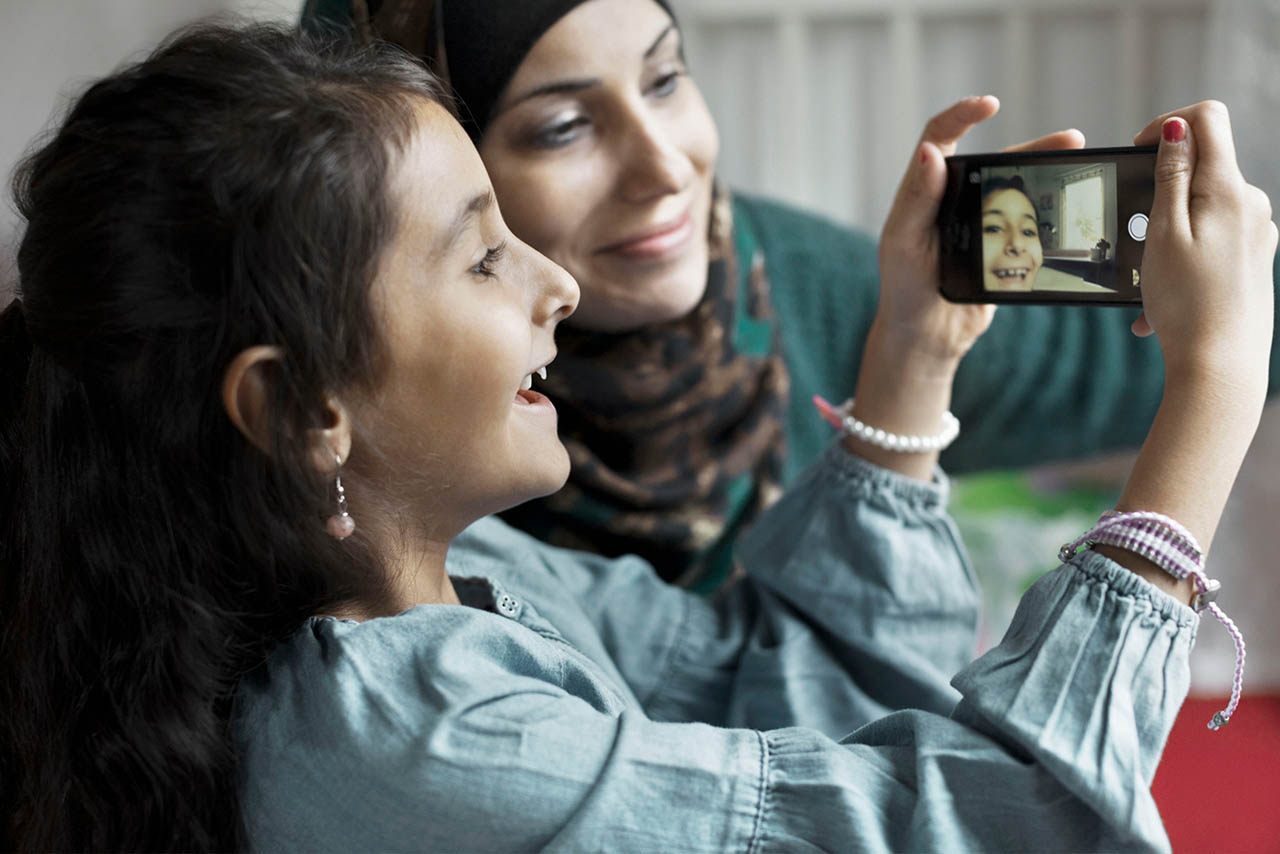
Lighting First Aid for the TikTok-generation
When lighting expert Shelley James realized how lockdown affects the wellbeing of kids and teenagers, she was shocked. Now she is joining forces with Fagerhult to improve the light health of the TikTok-generation.
Nieces halo and amity are two of the most important people in Dr Shelley James’ life.
”They’re such an inspiration to me”, she laughs.
With a PhD from the Royal College of Art and as an international expert on light and well-being (you might have seen her appearing on the award-winning BBC series ”Innovations that Changed the World” and on the webinar series the Neuroscience of Light) Shelley James has in-depth knowledge of how light affects our well-being through life. With her cheerful nieces around she has developed a deep commitment to improve the light health of teenagers.
”The adolescent brain is going through the most amazing process and it cannot be compared to the brain of a grown up. The connections between different parts of the brain are going through profound change, which is key to their health and happiness into adulthood and beyond. This, along with the rapid changes in their physical bodies, means that they need an hour more sleep than a ten year old”, Shelley James explains.
”In fact, the teenager’s circadian rhythm is running two hours late compared to an adult. That means that a 7am wake-up call for an adult feels like 5am for an adolescent. Might be good to know if you have teenagers around…”
ALARMING SITUATION
This said, the access to daylight and high-quality artificial light at the right time of day – with the right colour and in the right amount – is crucial for the health of teenagers always. In times of lockdown Shelley James finds the situation alarming. Homeschooling has resulted in wrecked routines and young people spending their days in their rooms with drawn blinds in front of a computer screen. Many of them do not go outside for long periods, meaning they are not getting any daylight at all.
”When lockdown came, I saw how young people around me were living in dark rooms and working in weak flickering light on the kitchen table. I was shocked by how little they knew about how their bodies and minds were affected by this.”
The common denominator between the rise in myopia, obesity, depression and learning difficulties among young people is the lack of good lighting, concludes Shelley James.
”We are already seeing problems with kids not getting enough sleep. When your body clock is not working properly it leads to struggles with obesity, mental health and concentration problems.”
SIMPLE SOLUTIONS
The good news is, that this can all be easily prevented, if only the teenagers themselves (and okay, their parents and teachers as well) had some basic lighting knowledge. It’s really simple, she says.
”Did you, for example, know that you don’t have to wear glasses just because your parents did? If you spend time outdoors, getting enough daylight when growing up, you can reduce the risk of ending up wearing glasses by up to 40 percent.”
Another fun fact that teenagers would benefit from knowing is that you can actually boost your brain with 20 percent higher learning capacity – just by switching of lights and screens and go to bed at the proper hour.
”In 2021, lighting is quite different than in it used to be. I think it’s a wonderful thing that development in the electronics has reduced a lot of the flicker – and tunable light is opening the door to different light colours to improve our well-being”, says Shelley James.
To take advantage of all opportunities offered, we have to raise the awareness among teenagers, their parents and scholars. And, maybe most important of all: we have to suggest practical solutions that are easy to understand and act upon.
THE BIRTH OF LUNA GOLIGHTLY
Said and done. After teaming up with some of the leading researchers and manufacturers within the lighting field, Shelley James launched the Luna Project of which Fagerhult is a very proud sponsor. Her idea is to address teenagers directly, helping them to gain insights and take actions to improve their health and wellbeing. And of course she turned to beloved nieces Halo and Amity for advice.
”Teenagers are amazing, thoughtful, lively people with loads of intelligence. They easily absorb this kind of knowledge, but we have to understand that this is the TikTok-generation, and they do not respond to traditional tutorials. They do want information but they don’t want to feel like they are being ‘taught’”, she muses.
Based on this insight ”Luna Golightly and the Fireflies” was born. Five short videos the fictional teenage girl Luna Golightly explains how young people can act ”light smart” in order to sleep better, prevent headache, improve their study results and even avoid wearing glasses. The videos are published on social media platforms like YouTube and TikTok. Of course, you can also find them at the Fagerhult website.
 "I grew up living in different countries around the world and it made me very aware of the different qualities of light from an early age." Dr Shelley James, founder Age of Light Innovations Group
"I grew up living in different countries around the world and it made me very aware of the different qualities of light from an early age." Dr Shelley James, founder Age of Light Innovations Group
INSPIRING KNOWLEDGE FOR ALL AGES
The Luna Golightly videos are supplemented with interviews and tutorials with international scientists and lighting specialists explaining the facts behind the films, among others Henrik Clausen, director of Fagerhult Lighting Academy.
”This material works as an introduction to the subject for parents and teachers. The scientist interviews can also be used to introduce different topics and activities if you want to deepen the discussion when teaching or talking with your kids, explains Shelley James, admitting that Luna is a passion project of hers.
”As adults we are the guardians of these young minds – and they are growing up really fast! For all of us that are passionate about light and lighting I think this is a no-brainer. No matter if you’re a lighting specialist, a specifier or a buyer – first and foremost, we are all mothers and fathers, grandparents or uncles – and of course, aunts. It is time for us to remember who we are doing this for.
SOME FACTS ABOUT DR SHELLEY JAMES
DR Shelley James is the founder of Age of Light Innovation.
She holds a PhD from the Royal College of Art and is an international expert on light and well-being. Current clients include Glaxo Smithkline, The Royal Society of British Sculptors and Bristol University. She is a passionate advocate for public engagement with science. She is Associate Artist at King’s College London, has an ongoing Residency at the Bristol Eye Hospital and a Visiting Lectureship at the Royal College of Art.
TEXT AMELIE BERGMAN
PHOTO MASKOT, SIMON PAULIN, MAGNUS LIAM KARLSSON, MARCUS AHMAD
Related News

Melanopic lux: lighting for education influenced by human biology
Light is essential in our daily lives, influencing our ability to see, overall well-being and performance. In educational environments, lighting quality can significantly impact students' focus, mood, and energy levels. So, how do we know what is the right amount and quality of light for this setting? Traditionally, light has been measured in lux, a unit of measurement for the intensity of light. It's used to measure how much light falls on a surface or the amount of light in a given space. One lux is the amount of light that falls on a surface that is one square meter in area when one lumen of light is spread out evenly. Recent advancements in research have unveiled the importance of melanopic lux, which goes beyond mere visibility. This measures how effectively light stimulates specific eye cells that regulate crucial non-visual functions such as sleep and alertness. In classrooms and lecture theatres, the melanopic ratio has become vital in lighting design, enabling educators to create spaces that support visual tasks and align with students' biological rhythms. In this article, we explore how lighting solutions can align with our biology, and how this helps to create optimum conditions for educational environments. The science of vision and light The human eye is a remarkable organ designed for high-resolution colour vision within a small area (approximately 2 degrees of the visual field) while relying on peripheral vision for motion detection. This dual-function system, shaped by evolution for survival, continues to influence how we perceive and interact with our surroundings. Our eyes are particularly susceptible to green and yellow light, reflecting our evolutionary adaptation to naturally lit environments. In contrast, blue light, which is chief in modern LED lighting, requires higher intensity to be perceived at the same level. Effective lighting design carefully considers brightness, timing, and distribution to support visual clarity and biological functions like mood and alertness. For example, exposure to bright light in the morning helps regulate circadian rhythms, boosting alertness and mitigating the effects of seasonal darkness. This is particularly important in educational environments, such as schools and universities, where lighting impacts mood, focus, and overall performance. Our Organic Response system provides an innovative solution tailored for these spaces. This smart lighting technology automatically optimises light levels, featuring daylight-responsive sensors and advanced occupancy detection, maintaining a balance between natural and artificial light. Doing so supports visual comfort and reduces energy consumption, making it an ideal choice for creating dynamic, efficient, and student-friendly learning environments. To further support students, well-lit spaces with minimal glare are essential for reducing eye strain and maintaining focus during extended study sessions. Adjusting light intensity and colour temperature for different tasks—such as reading, group discussions, or creative activities—enhances light's visual and non-visual effects. By integrating thoughtful lighting strategies like those offered by Organic Response, educational environments can promote healthier, more productive, and engaging learning experiences. Integrative lighting: Supporting health and well-being. Integrative lighting (also referred to as human-centred lighting) combines visual and non-visual benefits (such as emotional effects) to support biological rhythms and psychological well-being. This approach goes beyond traditional lighting solutions by considering how light impacts circadian rhythms and hormonal balance. Light exposure in the morning is critical for suppressing melatonin (the sleep hormone) and increasing cortisol (the alertness hormone). Proper timing helps align students' natural rhythms with school schedules, which often require a lot of focus. Consistent exposure to bright, cool light early in the day can enhance energy levels and cognitive performance. The melanopic ratio compares the spectral composition of a light source with daylight. Using this information, you can determine its melanopic lighting intensity. This enables the design of lighting setups that precisely meet both visual and biological lighting needs. Lighting recommendations for educational spaces Each learning environment has unique lighting needs. Libraries benefit from direct lighting on the floor, paired with ambient lighting on walls and ceilings. Vertical shelf lighting (200-300 lx) makes it easier to browse titles. Lecture halls, on the other hand, require glare-free, comfortable lighting with flexible control, ideally with pre-programmed scenarios. In auditoriums and classrooms, strong vertical lighting is crucial for clear visual communication, especially over greater distances, enhancing facial expressions and engagement. General lighting recommendations apply to all educational spaces. Our solutions meet industry standards, ensuring reading and writing areas maintain 500 lx for effective visual tasks. Using daylight-responsive sensors for luminaire rows can reduce energy consumption while maximising natural light. The number and arrangement of luminaires should be adjusted based on the room's size and function to ensure consistent illumination. The role of dynamic lighting A Double Dynamic lighting system can be a game-changer in educational environments. It allows for intensity and colour temperature adjustments to match the specific needs of activities, from quiet reading sessions to collaborative group work. Fagerhult's distinct approach to lighting means that our design is human-centric; we integrate scientific insight into light and human psychology, creating environments that support academic performance and well-being. Our focus on energy efficiency also means our advanced control systems optimise light usage while minimising energy consumption, contributing to a building’s sustainability goals. The customisable setting and flexible solutions ensure that educational environments can create tailored lighting profiles for different times of the day or specific learning activities. Long-term benefits of melanopic lighting Melanopic lighting, designed to mimic the natural light spectrum, helps regulate the circadian rhythm, which is essential for maintaining focus, energy, and emotional balance. In classrooms and study areas, proper lighting can reduce eye strain, improve sleep patterns, and enhance mood, which are critical for students' mental health and academic performance. By incorporating lighting that aligns with our biological needs, schools and universities can foster healthier, more productive learning environments,. This is particularly important during the winter months when daylight is limited. Whether through advanced tuneable white light systems, designs that maximise daylight, or energy-efficient solutions, we are dedicated to leading the way in lighting innovation for educational environments, delivering brighter futures—one classroom at a time.
The inspiration behind Nobel Week Lights: ”Light, art and technology intertwined.”
Nobel Week Lights has quickly become a beloved public celebration. During Nobel Week, Stockholm residents flock outdoors to marvel at the spectacular light installations, where contemporary lighting technology meets artistic expression. ”We aim to create a moment of gathering: around light and around something meaningful”, says Lara Szabo Greisman. Nobel Week Lights is a light festival that illuminates Stockholm during the darkest time of the year – a free cultural experience for everyone. Presented by the Nobel Prize Museum, the festival invites international and local artists, designers and students to create light artworks inspired by the Nobel Prize. The installations shed new light on the scientific discoveries, literature and peace efforts of Nobel laureates while offering a fresh perspective on the city. Fagerhult is Principal Partner of Nobel Week Lights 2024, and this year’s edition features 16 different light installations across Stockholm. The artworks can be experienced from 7–15 December, including ”The Wave”, a light installation by the art collective Vertigo, located in front of the Parliament House where visitors can walk right through the luminous wave. The Wave by Vertigo ”Light and art and creativity is incredibly intertwined because these are technologies that are constantly evolving. So part of the fun working with the artists is that they are constantly testing new technologies. And we see these incredible visual results which are based on just pure innovation”, says Lara Szabo Greisman, co-founder and producer of Nobel Week Lights. Lara Lara Szabo Greisman and Leading Lights by Les Ateliers BK The significance of light as a collective force, its ability to encapsulate life and death, joy and sorrow – indeed, the very essence of what it means to be human – makes lighting a powerful medium of artistic expression, she argues: ”The dream for the festival is that this becomes a personal experience for each and every member of the audience. A moment that they remember and cherish . A moment that they think about later and bring forward as their story of connecting with the city.”


